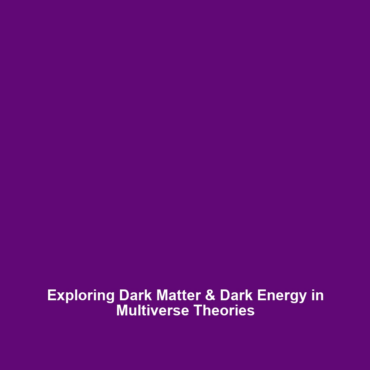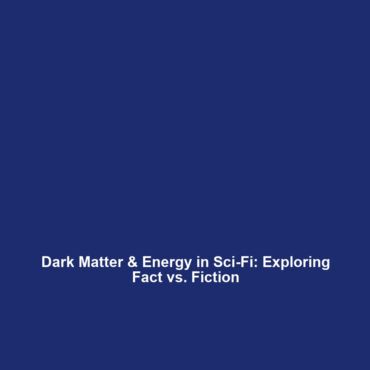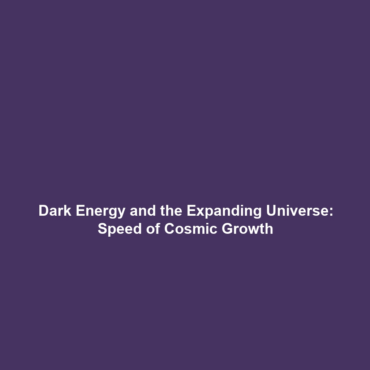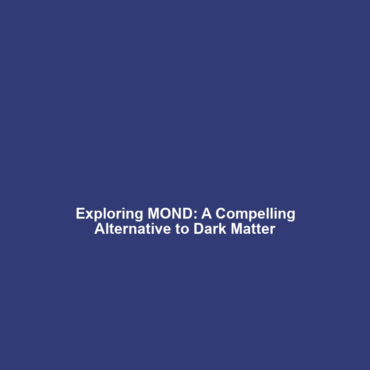Dark Matter and the Bullet Cluster: A Smoking Gun?
Introduction
Dark Matter remains one of the most perplexing components of our universe, accounting for nearly 27% of its mass-energy composition. Among various evidential phenomena, the Bullet Cluster stands out as a crucial case study. This astronomical collision of clusters of galaxies offers compelling evidence supporting the existence of Dark Matter and sheds light on the mysteries of Dark Energy. Understanding the Bullet Cluster is paramount for astrophysicists as it provides insights into both the behavior of Dark Matter and the expansion of the cosmos.
Key Concepts
Understanding Dark Matter
Dark Matter is known to interact with regular matter through gravitational forces but does not emit or absorb light, rendering it invisible and detectable only through its gravitational effects. The Bullet Cluster, formed from the collision of two galaxy clusters, provides a unique laboratory for studying Dark Matter due to its clear separation between visible matter and the gravitational mass.
The Bullet Cluster Phenomenon
The Bullet Cluster, officially known as 1E 0657-56, demonstrates the presence of Dark Matter through the mapping of its gravitational lensing effect. Observations reveal that most of the mass in the cluster lies in regions where no visible galaxies or gas are present, implying substantial Dark Matter presence. This scenario continues to be an essential component of the discussion surrounding Dark Matter & Dark Energy.
Applications and Real-World Uses
The study of Dark Matter and the Bullet Cluster has numerous applications in the field of cosmology and astrophysics:
- Enhancing Theoretical Models: The findings related to the Bullet Cluster help refine models of cosmic evolution and structure formation.
- Guiding Astrophysical Surveys: Understanding Dark Matter distributions aids in planning future surveys intended to map the universe’s structure.
- Implications for Dark Energy Research: Insights gained from Dark Matter investigations are crucial in exploring the nature of Dark Energy and its influence on cosmic expansion.
Current Challenges
Despite the compelling evidence, several challenges persist in the study of Dark Matter and the Bullet Cluster:
- Detection Methods: The inability to directly detect Dark Matter particles is a significant hurdle, limiting the scope of research.
- Interpretation of Results: Discrepancies between observational data and theoretical predictions call for improved models of Dark Matter interactions.
- Technological Limitations: Further observational technologies are required to gather more conclusive evidence regarding Dark Matter’s properties.
Future Research and Innovations
The future of Dark Matter research is promising and may yield groundbreaking results:
- Next-Generation Observatories: Facilities like the Square Kilometre Array (SKA) are expected to accelerate the discovery of Dark Matter phenomena.
- Particle Physics Experiments: Experiments such as the Large Hadron Collider (LHC) continue to explore potential particles that could compose Dark Matter.
- Cosmological Simulations: Advanced computer simulations will enhance our understanding of cosmic structures and Dark Matter distribution, providing a clearer view of Dark Energy’s role.
Conclusion
The Bullet Cluster serves as a significant piece of evidence in the ongoing quest to understand Dark Matter and its association with Dark Energy. Its study has far-reaching implications not only for astrophysics but also for our understanding of the universe’s fundamental nature. As research progresses, it is crucial to stay informed about these developments. For further insights, explore our articles on Dark Matter Theories and The Nature of Dark Energy.









